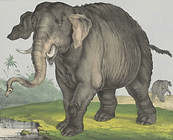
"The relationship, though distant, between the Macrauchenia and the Guanaco, between the Toxodon and the Capybara,—the closer relationship between the many extinct Edentata and the living sloths, ant-eaters, and armadillos, now so eminently characteristic of South American zoology . . . are most interesting facts. This wonderful relationship in the same continent between the dead and the living, will, I do not doubt, hereafter throw more light on the appearance of organic beings on our earth, and their disappearance from it, than any other class of facts."
-- Charles Darwin, Voyage of the Beagle
Whimsical stories for children abound in imagery that may introduce serious Darwinian thinking, the science that answers questions of origins. Incipient notions of natural selection lurk in the lives of Rudyard Kipling's Elephant Child, Leo Lionni's Minnow, and Bill Peet's Chester the Pig. Paying close attention to limbs and toes offers clues that connect living creatures to their common ancestors. do elephants have knees? illustrates these themes and at the same time portrays the originator of scientific stories of origins, Charles Darwin, not as a dyspeptic Victorian sage but more as a swashbuckling worm scientist.




